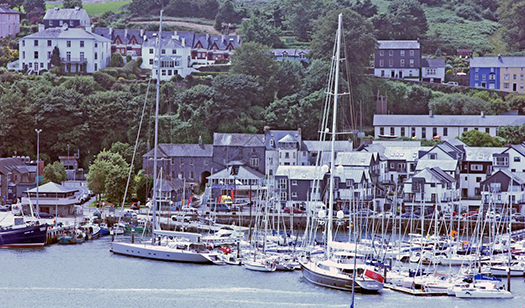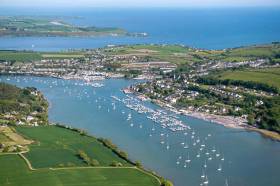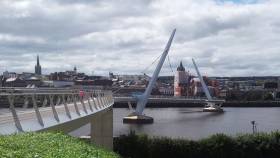Displaying items by tag: Cool Route
Does ‘Cool Route’ Have Its Figures Right In Moves On Superyacht Market?
#CoolRoute - The growing superyacht market is a target audience of the new Cool Route initiative, which is pitching the string of coastal marinas between Ireland and Norway as a top-tier cruising destination.
But is the project’s research up to snuff? Not according to SuperyachtNews’ Rory Jackson, who argues that the scheme’s moves towards the premium superyacht tourism business are naive, and not based on accurate figures.
“[To] describe the opportunities provided by the superyacht market as ‘low hanging fruit’ highlights an incredibly ill-conceived understanding of how the superyacht market operates,” writes Jackson, who also queries the project’s strategy report on its high estimates for superyacht prices, whether to own or hire.
There can be no denying that the Cool Route has a lot to offer superyacht owners,” he adds. “But, any attempt to lure superyachts on an increasingly regular basis must not be rushed.”
SuperyachtNews has more on the story HERE.
Cool Route: Not About Sailing from Cork to Tromso But Enjoying Cruising Grounds on its Route
The Cool Route Project, funded by the EU’s Northern Periphery and Arctic Programme and led by Cork Institute of Technology, commenced in June 2015. Since then, as Afloat.ie reported previously, project partners in Ireland Northern Ireland, Scotland, the Faroe Islands and Norway have been working hard to study and develop strategic initiatives to build the route, covering all of the cruising grounds between Cork and Tromsø, as a world recognised cruising area.
The project workpackage to develop a Route Marketing strategy was led by project partner, The Royal Cork Yacht Club, based in Crosshaven, Co. Cork. Before developing the strategy, The Royal Cork, in the almost complete absence of statistics on sailing in Northern Europe, had to undertake a number of different studies.
The first study undertaken was a Cruising Preferences Study, with over 500 highly qualitative responses received, mainly from Ireland and the UK - the study highlighted the needs preferences and priorities of cruising sailors. A key finding being that the preferred daily journey was 25 nautical miles.
Cruising folk also like very much to have a dry step ashore, be that on to a marina or a pontoon. If they have to moor offshore, they are slightly in favour of anchoring rather than using a public mooring, stating reasons of distrust.
 New pontoon facilties in Killybegs in County Donegal are important to the establishment of the Cool Route. Photo: WM Nixon
New pontoon facilties in Killybegs in County Donegal are important to the establishment of the Cool Route. Photo: WM Nixon
An interesting finding of the comprehensive study was that 65% of respondents stated that they would consider chartering as an option to explore different areas of the route.
Equipped with the preferred daily cruising distance, partner Glasgow Caledonian University, was then positioned to complete its Route Logistics Study and Gap Analysis. The logistics study clearly demonstrates that, with the exception of the west coast of Ireland, there are no distance gaps of over 25mnm, other than the sea crossings from Northern Ireland to Scotland and Scotland to the Faroe Islands and Norway. There are a number of facilities gaps in terms of showers and toilets.
Ideally the project would like all stopovers to have these facilities. Waste disposal is also an issue, and failed to find a suitable solution, as areas around local bins were consistently being used for fly-tipping. The project has also researched, and made recommendations, on a modular design for a toilet and shower block, which is manufactured from recycled shipping containers, easily transported and installed.
The next research task completed towards the finalisation of the marketing strategy was to undertake a Route Traffic Study. The study estimated the total numbers of cruising vessels located throughout the route and also calculated the numbers and locations of vessels within a two day voyage of any part of the route. In all there are in excess of 150,000 vessels capable of voyaging different parts of the route.
Gavin Deane, General Manager at The Royal Cork, stresses that: “The Cool Route is not about sailing from Cork to Norway, but enjoying all of the cruising grounds along the route. UK Boats may likely just come to the South Coast of Ireland for a week, or Northern Ireland and Scottish boats may make reciprocal trips. The project is firmly focussed on bringing new marine borne business to local enterprises and it does not make a difference if the visiting boat originated its voyage 10 miles or 100 miles from its destination. The important aspect is that a visiting craft bring business to local harbours.”
 Superyachts moored at Kinsale in County Cork
Superyachts moored at Kinsale in County Cork
During the summer of 2016 partners in Ireland and Scotland witnessed a growth in the numbers of superyachts visiting. A focus group of 25 superyacht skippers was assembled and the feed-back was clearly to immediately market the route to these craft, who were actively looking for new voyages. Superyachts do not require any additional facilities than ordinary cruising craft with an emphasis on a dry step ashore and facilities to take and recycle waste.
Visits to areas of the route by small liners with 100 or so passengers was also a developing trend.
The Royal Cork Yacht Club, as part of its Cool Route marketing brief, has now produced a very high quality Superyacht Marketing Brochure, containing both generic information on the overall route, as well as a set of national inserts on reach of the participating coastal areas. The brochure is available in hard copy for circulation to superyacht and small liner operators, owners and skippers and also in an online version which can be downloaded here
In publishing the Route Marketing Strategy, which can be downloaded here, the partners are calling on higher levels of proactivity by local ports to encourage visitors.
Dr Breda Kenny, Head of the Hincks Centre for Entrepreneurship Excellence at CIT, who is leading the project said
“The strategy involves action by the main beneficiaries. This may involve organising weekend events at ports, perhaps including a barbecue or music and entrainment.Twenty visiting boats can bring between 60 to 100 visitors, the presence of boats in your harbour will bring as many day visitors and this combined effect can have significant economic benefits for local shops, cafes, restaurants, museums etc.”
One of the main strategic actions proposed is for national yachting associations and clubs in Ireland, Northern Ireland and Scotland to organise a Cool Route stand at International Boats Shows. The shared stand will have a much greater impact that any one of the individual stands – It will market all of the Cool Route as prime world cruising grounds. National interests will still compete for the business – but to a significantly larger audience.
All of the Cool Route research and studies to date can be viewed and downloaded here.
#CoolRoute - With their city's namesake yacht's performance in the Clipper Race firmly in mind, Derry officials met with fellow Cool Route partners in Glasgow last week ahead of hosting their own project meeting this October.
As Derry Now reports, the recent two-day gathering allowed partners in the Cool Route cruising initiative to discuss various aspects of the project, with Derry leading talks on IT and online booking.
Cool Route partners – which include Cork Institute of Technology and Donegal County Council – also met with marine leisure industry stakeholders to share insights and feedback.
Derry Now has more on the story HERE.































































